“In recent years, there has been a reawakening of interest in colored glassware for its beauty appeal and vintage charm.
However, as consumers increasingly seek out unique and colorful drinking vessels, questions about the safety of drinking from colored glass have emerged. Is colored glass safe to drink from? or does it pose potential health risks?
This article explores the science underlying colored glasses, looking at things such as the components used, the production method, and the possibility of dangerous compounds leaking into drinks.
We want to make it clear whether using colored glass is a safe choice for enjoying your favorite drinks.”
HOW TO TELL IF DRINKING GLASS CONTAINS LEAD?
There has long been discussion over whether your drinking glass is lead-free or includes lead. Even separating lead-free crystal from lead-free glass can be a challenging task.
Tapping a drinking glass lightly with a knife or your finger is one of the easiest and most popular ways to check if it contains lead. Lead glass sounds dull; lead-free glass sounds sharp.
Another method to determine whether your drinking glass is lead-free is to look for the Logomark since lead-free glassware is typically made of high-quality ceramics and includes potassium. It also typically has a lead-free logo on the outside of the container.
Observing the color of your drinking glass is another method you can use to determine if it contains lead or not. Lead-free glass goods can more accurately display the refractive qualities of glass due to their superior refraction over regular lead crystal glass.
The drinking glass’s weight also establishes whether or not it contains lead. Products constructed from crystal glass that contain lead are often a bit heavier than those that don’t.
Finally, consider the drinking glass’s resilience; lead-free drinking glasses are not as durable as lead-containing crystal glasses
WHAT GLASS IS SAFE TO DRINK FROM?
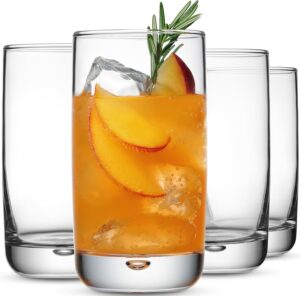
Glassware made specifically for drinking, such as drinking glasses or cups, is generally safe for drinking. You can drink from glasses made from tempered glass or soda-lime glass, as these are the most common types used for food and beverage consumption.
Always avoid drinking from damaged or chipped glassware, as it can pose a safety hazard.
READ ALSO: WHAT ARE THE SAFEST DRINKING GLASSES
IS COLORED GLASS SAFE TO DRINK FROM?
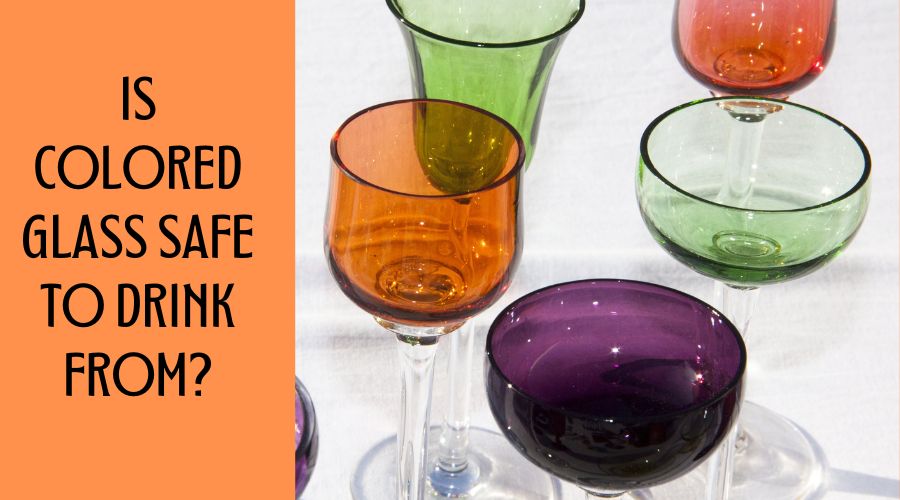
Whether a colored glass is safe or unsafe to drink depends on the type of color used on it.
In general, colored glassware that complies with applicable safety rules is free from problems and is constructed of high-quality materials that are safe to drink from. It is also important to inspect your glassware for damage.
Note that certain colored glassware, particularly that which is imported from areas with loose laws, may contain dangerous materials like lead or cadmium.
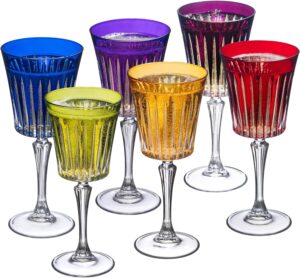
Before using glassware for eating or drinking, be sure it has a label stating that it is safe for food or drink. A home lead test kit can be used to detect lead in glass.
If you have concerns about a specific piece of colored glassware, it’s best to avoid using it for drinking purposes.
KHEN-FASHIONED DRINKING GLASSES

Each glass holds 9.6 ounces of your favorite beverage, whether it’s a refreshing cocktail, a smooth bourbon, a classic Manhattan, or simply water.
These glasses, which were carefully made with amazing attention and care, have a timeless style and subdued hues that elevate any dinner setting or home bar.
A comfortable grip is provided by their ideal size and weight, which also guarantee durability and allow you to enjoy every drink.
Whether you’re hosting a gathering with friends, enjoying a quiet evening at home, or searching for the perfect gift for a loved one, our Old-Fashioned Drinking Glasses are sure to impress.
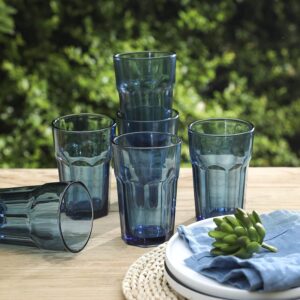
These textured glasses are dishwasher-safe for easy care. The color will not peel off the glass or fade after many washes and uses. Made of thick and solid glass for a safe drink. These tumblers are sure to last with proper care.
Other Glassware for your Barware;
COLLINS EVERYDAY DRINKING GLASSWARE SET
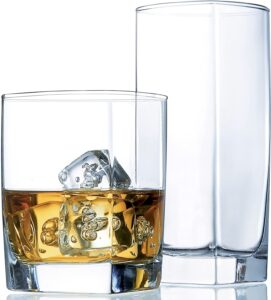
The Collins Everyday Drinking Glasses Set is a complete set that will improve your enjoyment of beverages.
This set includes 8 tall highball glass cups and 8 short old-fashioned glasses to satisfy all your drinking demands, be it a crisp beer, a smooth whiskey, or an iced coffee in the morning.
These glasses, which are made with durability and style in mind, are ideal for every setting, from informal get-togethers to formal meals.
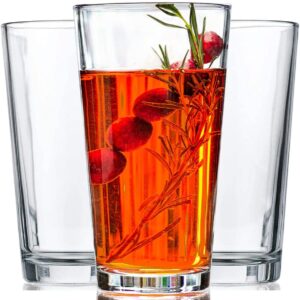
These glassware, are highly resistant to chemical corrosion. they do not react with chemicals, acids, or bases, making them safe for use in your kitchen or barware.
The Collins Everyday Drinking Glasses Set is a classic and versatile piece of kitchen or barware that will guarantee you’re always ready to serve your favorite beverages with style and grace.
Compared to other types of glass, borosilicate glassware is more durable and less prone to breakage. This durability ensures a longer lifespan for the glassware, reducing the need for frequent replacements.
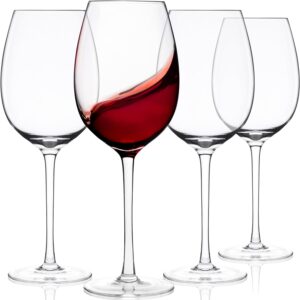
This glass is regarded as safe for use in activities involving food and drink. Because it doesn’t absorb dangerous chemicals, it’s a great option for everyday use.
This glass can withstand rapid temperature changes without shattering.
SAFEST GLASS TO DRINK FROM
For drinking purposes, tempered glass is generally considered one of the safest options. It’s designed to be more resistant to breakage and shattering compared to regular glass.
Different glassware kinds provide varying degrees of drinking safety. Let’s look into some examples;
Tempered Glass: Tempered glass is treated with heat to increase its strength and durability. It’s commonly used in drinkware, cookware, and even smartphone screens due to its resistance to shattering. Tempered glass is generally safe for drinking as it’s free from harmful chemicals like lead.
Borosilicate Glass: Borosilicate glass is perfect for both hot and cold beverages because of its great resistance to heat shock.
Additionally, it is less likely to break than regular soda-lime glass due to its increased durability.
Borosilicate glassware is frequently chosen for its adaptability and safety qualities, and it is typically regarded as safe for drinking.
Soda-Lime Glass: Soda-lime glass is the most common type of glass used in everyday drinkware. It’s made from silica, soda ash, and lime, and it’s generally considered safe for drinking. However, soda-lime glassware may contain trace amounts of heavy metals or other contaminants depending on the manufacturing process.
Choosing high-quality soda-lime glassware from reputable brands can help minimize any potential risks.
Silicone and Stainless Steel: For those concerned about glass breakage or looking for alternatives to traditional glassware, silicone and stainless steel offer safe and durable options for drinking.
Silicone is flexible, lightweight, and BPA-free, making it suitable for both hot and cold beverages. Stainless steel is also a popular choice due to its durability and resistance to corrosion.
IS BLUE GLASS SAFE TO DRINK FROM?
Not all blue glasses contain leaching lead which means some blue glasses are safe to drink from while some blue glasses are not safe to drink from.
Blue glasses made from cobalt, do not contain leaching lead because the cobalt material itself does not leach.
CAN YOU DRINK FROM PAINTED GLASS?
No, it’s not safe to drink from painted glass. The paint may contain harmful chemicals that could leach into your drink, posing health risks. It’s best to use glassware that is specifically designed Lead and cadmium-free for your food and beverages.
Many paints, particularly those containing lead or other heavy metals, can pose health risks if ingested. When these substances come into contact with liquids, they may dissolve or flake off, contaminating the beverage and posing a risk of ingestion.
some painted glassware may be labeled as food-safe, so it’s essential to exercise caution and consider the potential risks.
If you have chipped or faded painted glassware, is best not to drink from it, instead, we advise you to get safe drinking glassware for you and your family.
IS COBALT GLASS SAFE TO DRINK FROM?
There are 0.1 chance that the cobalt material can leach. This said, no amount of drinking from a cobalt glass will make you consume unhealthy cobalt that could make your family run helter-skelter for your sake.
The material cobalt is a toxic material that can pose serious health threats when inhaled, however, the finished product which is the glass made of cobalt is not unsafe to drink from.
DOES COLORED GLASS CONTAIN LEAD?
Lead can be present in colored glass, however, it relies on some conditions, such as:
1. The glass’s age: Lead is more likely to be present in older colored glass, especially that which was made before the 1950s. Lead was widely employed in glassmaking until health dangers were raised.
2. The kind of tinted glass: Lead was used more frequently to create colors like red and yellow than other hues.
3. The glass’s intended use: Dishes and glassware are more likely than ornamental glass products to contain lead.
It is important to note that lead is not present in all colored glass. Not only are there lead-free copies of vintage colored glass available, but many current makers employ other techniques to achieve color.
Here are a few more points to remember:
It is advisable to refrain from using older colored glasses for eating or drinking if you are worried about being exposed to lead.
A home lead test kit can be used to detect lead in glass. It is advisable to err on the side of caution if you are unsure, though, as these kits are not always precise.
Because they are more susceptible to the effects of lead exposure, it is particularly important to exercise caution around lead exposure if you have children or pregnant women living with you.
DOES GLASS FROM CHINA CONTAIN LEAD?
It won’t be fair to profile a certain location and assume that all glasses produced in that location contain lead. However, it has been confirmed that 80% of glasses produced in China are made with harsh chemicals like lead.
We can blame it on the Chinese artifact and their love for colorful and fanciful glassware. Most Chinese glassware was made using sprayed colors that contained lead that could leach into food and drink.
But as technology evolved and new methods of glass beautification came on board, it is safe to say that modern Chinese glassware does not contain as much lead as it used to have in times past.
WHICH DRINKING GLASSES ARE LEAD-FREE?
Apart from checking labels for the notification that says ‘lead-free’, a safe way to avoid an unhealthy consumption of lead is to go for colorless glasses. Since it might be a bit tricky to distinguish between sprayed glass and solid glass.
IS IT SAFE TO DRINK FROM VINTAGE GLASSWARE?
vintage glassware adds a touch of romance and character to any table setting.
Vintage glassware, particularly pieces manufactured before the 1970s, may pose potential health risks due to the materials and techniques used in their production. One of the primary concerns is the presence of lead.
Lead was commonly used in the production of glassware to add brilliance and weight to the glass. However, it poses a significant health hazard, especially when it leaches into beverages.
Prolonged exposure to lead can lead to serious health issues, including neurological damage, developmental delays in children, and reproductive problems.
You can Determine whether vintage glassware contains lead by requiring specialized testing equipment.
A dull thud rather than a clear ring when the glass is tapped and a bluish or grayish color is two obvious indicators that the glassware contains lead. To be assured, professional testing might be required as these visual clues are not always reliable.
It’s important to remember, though, that not all antique glassware poses a risk. As the public’s understanding of the health dangers associated with lead and other hazardous compounds increased, many manufacturers made the switch.
Glassware made after the 1970s is usually safe to use, but one should still use caution, especially when handling unclear pieces.
IS BLUE GLASS SAFE TO DRINK FROM?
Not all blue glasses contain leaching lead which means some blue glasses are safe to drink from while some blue glasses are not safe to drink from.
Blue glasses made from cobalt, do not contain leaching lead because the cobalt material itself does not leach.
IS COLORED GLASS FOOD SAFE?
The solid glass which incorporated its color in the manufacturing of the glass gives the glass an extra toughness with minimal wash-off tendencies and is the safest to drink from.
Whether a colored glass is safe or unsafe to drink depends on the type of color used on it. Let’s remember that glass itself is colorless and whatever element of color is found on a glass cup was either sprayed or incorporated in other solid ways apart from spraying.
Let’s focus on sprayed paints. Glass cups with sprayed paints are harmful and are not considered safe to drink from. With each sip of water, you take, there is a 45% chance that you are sipping the sprayed paint as well.
The sprayed paint as the name implies is a coating or paint sprayed on the glass and as we already know, coatings can peel with time.
WHEN DID THEY STOP PUTTING LEAD IN GLASSES?
Following several reports of severe kidney, lung, and other damage instances resulting from lead poisoning, the US government implemented regulatory steps in the 1970s to assist lower the amount of lead used in glass.
The Toxic Substances Control Act, the Safe Drinking Water Act, and the Residential Lead-Based Paint Hazard Reduction Act of 1992 are a few of these organizations.
IS HAND-BLOWN GLASS SAFE TO DRINK FROM?
Yes, hand-blown glass can be safe to drink from. The safety depends on the materials used and the manufacturing process.
Ensure that the glassware is made from food-safe materials and that it has been properly annealed to strengthen it and reduce the risk of breakage.
READ ALSO: HOW SAFE IS THAT PAINTED DRINKING GLASS?
- Carbon Steel Pans for Wood Fired Oven - March 22, 2025
- Cookware for Wood Fired Oven - March 21, 2025
- Cast Iron Dutch Oven Pros and Cons - March 19, 2025